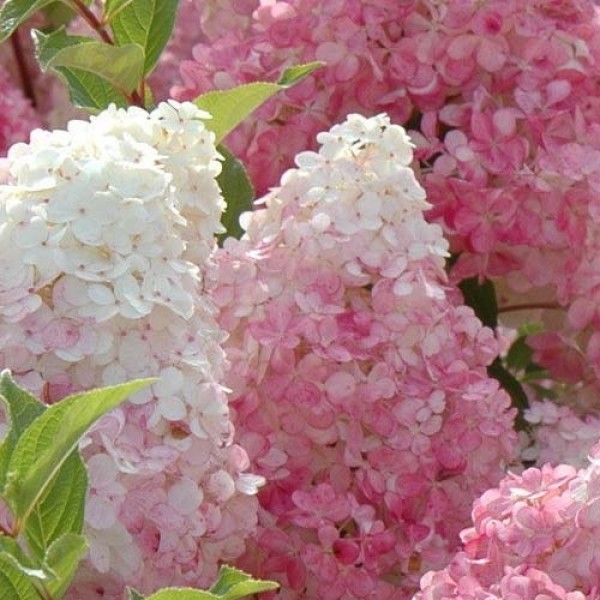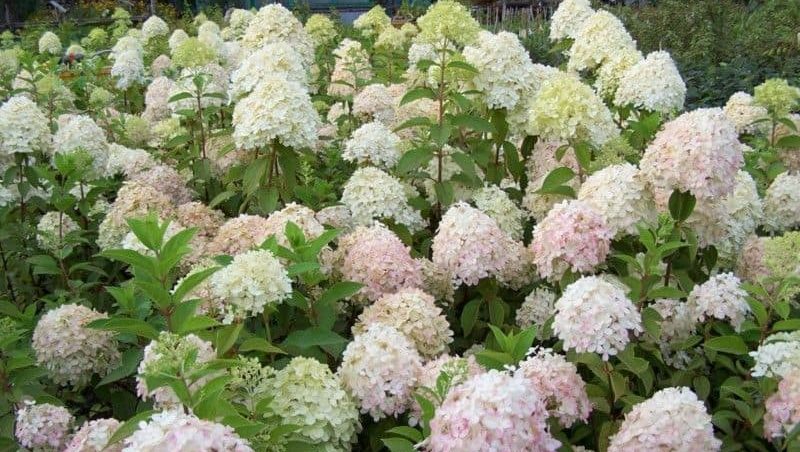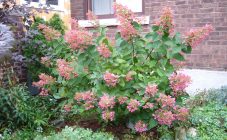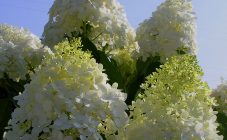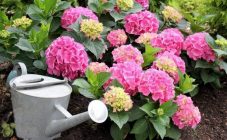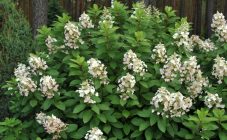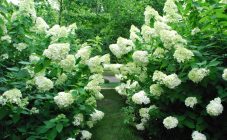Content:
One of the favorite perennials among landscape designers are panicle hydrangeas - perennial shrubs that can bloom throughout the summer without reducing active flowering in the fall. These bushes are unpretentious, undemanding to care, therefore experts recommend planting them in summer cottages as beautifully flowering plants.
The attention of summer residents in this article is offered to the panicle hydrangea Mega Mindy, the name of which was given for the huge inflorescences. The main advantages of the variety, the nuances of planting and further cultivation will be discussed below.
Brief description and characteristics of culture
Breeders in different countries of Europe and the world are engaged in breeding varieties of paniculate hydrangeas. Their goal is to breed shrubs with high resistance to frost, the ability to bloom throughout the warm season. The inflorescences of such hydrangeas themselves are in the form of large panicles (both in height and in width), in each of which a large number of flowers of different sizes bloom simultaneously.
Such shrubs "took root" in different countries of the world, they are actively used by landscape designers to decorate large parks and small squares. Hydrangeas also look good along busy highways, in large plants in green areas.
Hydrangeas are by nature unpretentious, so they get along well in any place.
Description of hydrangea Mega Mindy
Hydrangea Mega Mindy is striking in its beauty. The color of the inflorescences is interesting - when blooming, the petals of the buds have a boiling white color (sometimes with a blue tint), but over time, the petals acquire a pinkish or bright cherry color.
The height of the shoots can reach 1.5-1.7 m, the bushes are compact, but their crown is dense, has an oval shape. The upright stems are strong and powerful, do not bend under the weight of large paniculate inflorescences, like many other varieties of hydrangea. The foliage has an elliptical or ovoid shape, the color of the plates is dark emerald. The length of the leaves is 9-11 cm, the upper leaf plate is rough, by autumn the foliage gradually turns yellow.
Very large flowers are collected in racemose inflorescences, beautifully hanging from vertical shoots. The variety begins to bloom in the second decade of July, and ends in early October. But if the weather is warm, then new inflorescences may appear until the onset of cold weather.
Many gardeners collect dried inflorescences and make dry bouquets from them, which they decorate the premises with until spring. But if the panicles are not cut, then they, without changing color, can remain on the bushes throughout the winter period. Therefore, this shrub does not lose its decorative effect throughout the year.
Another advantage of the variety is its high resistance to frost, so the Mega Mindy hydrangea can be grown in most regions of our country.
Planting
Before talking about planting these hydrangeas, you should describe the process of their reproduction. They can be propagated by seed, grafts, cuttings or dividing the mother bush. The first methods are extremely inconvenient and take too long.Therefore, the last two methods are usually used for reproduction:
- Propagation by cuttings. To do this, cuttings are cut from the annual lateral stems, which are best rooted in the second decade of July. The cuttings are planted in the following substrate: equal shares of river sand and high moor peat are mixed, sphagnum moss is added for moisture capacity. Cuttings are placed at an acute angle, the distance between adjacent plants should be at least 4-6 cm. The best temperature regime for their rooting is + 17 + 19 ° C. After 30-35 days, the cuttings give roots and they can be transplanted to a permanent place.
- The division of the bush is usually carried out when transplanting the bush to a new location. Usually, this procedure is carried out every 5-6 years, changing the area for growing these flowers. The time of this procedure does not matter - from spring to autumn at any time convenient for the grower. The bush is carefully dug out (it is advisable not to injure the root system especially), then it is divided into several divisions, each of which must have at least 2 buds. Each piece is planted immediately on a permanent pre-prepared place. With the correct procedure, young bushes begin to bloom the next year.
It is better to plant Mega Mindy hydrangea seedlings in the middle lane and other regions with a similar climate in the spring, then the plants will have time to take root in a new place in a short summer season, and by winter they will be already strong and strong. In the southern regions, these flowers can be planted in a permanent place both in spring and autumn.
Planting holes should have a diameter of about 0.6 m and a depth of about 0.4 m. The diameter of the hole should be slightly larger than the volume of the crown. And to create a hedge, a trench 0.9-1.1 m wide is dug from this shrub, into which the seedlings are placed at a distance of 1.5 m from each other, and then they carefully bury it.
Further care
In the future, the main care for hydrangea can be reduced to the implementation of some rules.
- Regular watering. Irrigation always keeps the soil around the plants moist. After each watering, you need to mulch the near-stem circles with needles, humus or chips so that the moisture evaporates more slowly.
- Adult perennials can easily tolerate even severe frosts without shelter. Before the onset of winter, cover only those plants that were planted in the current season.
- Hydrangea Mega Mindy grows rapidly and blooms actively, spending a lot of nutrients on it. Therefore, it should be fed at least 4 times per season, alternating organic and mineral fertilizing.
- Pruning of these perennials is carried out in spring and autumn. At the same time, all weak, broken and frozen branches are removed, as well as excess shoots that contribute to the thickening of the bushes. In autumn, annual branches are shortened, leaving no more than 4-5 buds on each.
Diseases and pests, control methods
The following diseases and pests can affect this hydrangea:
- A spider mite that usually settles on the underside of foliage. Its presence can be seen by the foliage curling downward, yellowing and cobweb formation. You can fight this pest by treating the vegetative mass with Thiophos solution.
- Downy mildew affects the vegetative mass of hydrangeas. Its main features are the appearance of small oily spots of yellow color. Gradually they grow and merge into one large spot. To combat this disease, a solution of copper sulfate with green soap is used (for 15 g of sulfate - 150 g of soap, everything is dissolved in a bucket of water).
- Chlorosis, which manifests itself in a sharp change in the color of the leaves to a lighter color. An illness occurs due to a lack of iron. For treatment, spraying the vegetative mass with potassium nitrate is used, and then a solution of ferrous sulfate is introduced into the soil.
- In greenhouse conditions, the Mega Mindy hydrangea can be attacked by green leafy aphids. It is not too difficult to deal with it - it is enough to treat the shrubs several times with anabasine sulfate solution.
Landscape designers use this hydrangea variety as a hedge, in single or group plantings, along with other plants growing in acidic soils.
Coniferous shrubs and small trees, some evergreens are usually used as neighbors.

